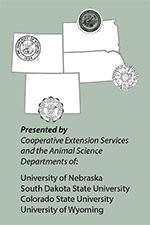Specialist Offers Advice for Range Mineral Nutrition
Mineral interactions and availabilities complicate supplementation strategies.
CHEYENNE, Wyo. (Nov. 28, 2017) — While it is widely believed that cattle possess a certain amount of “nutritional wisdom,” producers must realize that cattle do not intuitively know when they need specific nutrients necessary for optimum performance. University of Nebraska Beef Systems Specialist Mary Drewnoski offered that warning to cattlemen attending Range Beef Cow Symposium XXV, hosted Nov. 28-30 in Cheyenne, Wyo.
According to Drewnoski, cattle may exhibit nutrient-seeking behavior when extremely (clinically) deficient in some minerals, but much less obvious subclinical deficiencies are far more common and may hinder calf growth, immune status and reproductive performance. That’s why a sound mineral supplementation program is important.
“On the surface, planning a mineral supplementation program seems simple. Just evaluate the mineral requirements of the animal and compare it to the intake of mineral in the diet. Then, supplement what does not meet the requirement,” said Drewnoski.
“Unfortunately, minerals interact with each other and other components of the diet, making mineral nutrition complex,” she said. “Precision supplementation is virtually impossible, especially in grazing situations where determining the mineral intake and providing supplemental mineral are in and of themselves challenging.”
Drewnoski said mineral elements likely to be deficient in forage-based diets are the macro minerals (including calcium, phosphorus, sodium and magnesium) and trace minerals (including manganese, zinc, cobalt, copper, iodine and selenium). Deficiencies typically occur when dietary intake of minerals does not meet requirements, or when antagonisms reduce the availability of the mineral to the animal. Additionally, mineral sources differ in bioavailability as not all mineral sources are absorbed to the same extent.
“Concentration does not equal availability,” stressed Drewnoski. “No nutrient is in the body until it is absorbed, so bioavailability is important.”
Drewnoski said each mineral in the diet must be evaluated for amount, bioavailability of the source and possible interactions with other minerals. Therefore, formulation of mineral supplements is both a science and an art. However, there are some common guidelines that can be useful for developing an effective mineral supplementation program.
According to Drewnoski, the trace-mineral content of forages can vary considerably, so testing forages for mineral content can be useful when developing an appropriate mineral supplementation program that is both cost-effective and meets animals needs.
Editor’s Note: This summary was written under contract or by staff of the Angus Journal®, which retains the copyright. To request to reprint this article, contact Shauna Rose Hermel, editor, at 816-383-5270. PowerPoints are posted with permission of the presenter and may not be reproduced in whole or in part without the express permission of the presenter. Angus Journal claims copyright to this website as presented. We welcome educational venues and cattlemen to link to this site as a service to their audience.
The Angus Journal's coverage of the event is made possible in collaboration with the event committee. For questions about this site, or to notify us of broken links, click here. Look for additional coverage in the Angus Journal, the Angus Beef Bulletin, the Angus Journal Daily, the Angus Beef Bulletin EXTRA and The Angus Report.


